Databricks Databricks-Certified-Data-Engineer-Associate Databricks Certified Data Engineer Associate Exam Exam Practice Test
Total 153 questions
Databricks Certified Data Engineer Associate Exam Questions and Answers
A data engineer has joined an existing project and they see the following query in the project repository:
CREATE STREAMING LIVE TABLE loyal_customers AS
SELECT customer_id -
FROM STREAM(LIVE.customers)
WHERE loyalty_level = 'high';
Which of the following describes why the STREAM function is included in the query?
Which of the following is a benefit of the Databricks Lakehouse Platform embracing open source technologies?
A data engineer wants to create a new table containing the names of customers that live in France.
They have written the following command:
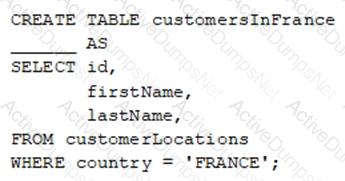
A senior data engineer mentions that it is organization policy to include a table property indicating that the new table includes personally identifiable information (PII).
Which of the following lines of code fills in the above blank to successfully complete the task?
Identify the impact of ON VIOLATION DROP ROW and ON VIOLATION FAIL UPDATE for a constraint violation.
A data engineer has created an ETL pipeline using Delta Live table to manage their company travel reimbursement detail, they want to ensure that the if the location details has not been provided by the employee, the pipeline needs to be terminated.
How can the scenario be implemented?
A data engineer wants to reduce costs and optimize cloud spending. The data engineer has decided to use Databricks Serverless for lowering cloud costs while maintaining existing SLAs.
What is the first step in migrating to Databricks Serverless?
A data engineer is designing an ETL pipeline to process both streaming and batch data from multiple sources The pipeline must ensure data quality, handle schema evolution, and provide easy maintenance. The team is considering using Delta Live Tables (DLT) in Databricks to achieve these goals. They want to understand the key features and benefits of DLT that make it suitable for this use case.
Why is Delta Live Tables (DLT) an appropriate choice?
A data engineer is working in a Python notebook on Databricks to process data, but notices that the output is not as expected. The data engineer wants to investigate the issue by stepping through the code and checking the values of certain variables during execution.
Which tool should the data engineer use to inspect the code execution and variables in real-time?
Which of the following describes a scenario in which a data team will want to utilize cluster pools?
A global retail company sells products across multiple categories (e.g.. Electronics, Clothing) and regions (e.g.. North. South, East. West). The sales team has provided the data engineer with a PySpark dataframe named sales_df as below and the team wants the data engineer to analyze the sales data to help them make strategic decisions.
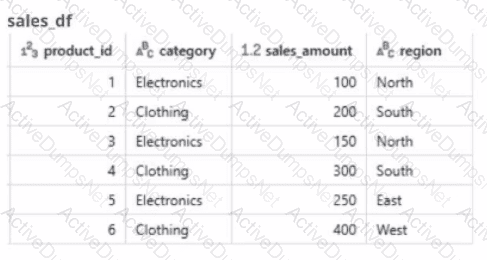
Which TWO items are characteristics of the Gold Layer?
Choose 2 answers
Which of the following tools is used by Auto Loader process data incrementally?
Which of the following commands will return the location of database customer360?
A data engineer is writing a script that is meant to ingest new data from cloud storage. In the event of the Schema change, the ingestion should fail. It should fail until the changes downstream source can be found and verified as intended changes.
Which command will meet the requirements?
A data engineer has configured a Structured Streaming job to read from a table, manipulate the data, and then perform a streaming write into a new table.
The code block used by the data engineer is below:
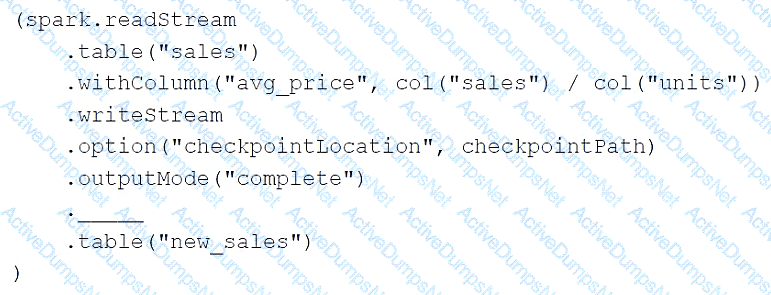
If the data engineer only wants the query to process all of the available data in as many batches as required, which of the following lines of code should the data engineer use to fill in the blank?
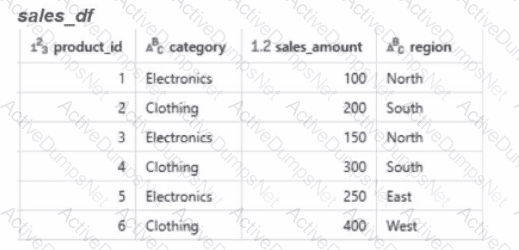
Calculate the total sales amount for each region and store the results in a new dataframe called region_sales.
Given the expected result:
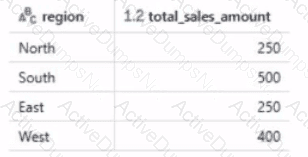
Which code will generate the expected result?
A data engineer needs to combine sales data from an on-premises PostgreSQL database with customer data in Azure Synapse for a comprehensive report. The goal is to avoid data duplication and ensure up-to-date information
How should the data engineer achieve this using Databricks?
Which SQL keyword can be used to convert a table from a long format to a wide format?
A data engineer needs to apply custom logic to string column city in table stores for a specific use case. In order to apply this custom logic at scale, the data engineer wants to create a SQL user-defined function (UDF).
Which of the following code blocks creates this SQL UDF?
A data engineer has been given a new record of data:
id STRING = 'a1'
rank INTEGER = 6
rating FLOAT = 9.4
Which of the following SQL commands can be used to append the new record to an existing Delta table my_table?
Which tool is used by Auto Loader to process data incrementally?
A data engineering team has two tables. The first table march_transactions is a collection of all retail transactions in the month of March. The second table april_transactions is a collection of all retail transactions in the month of April. There are no duplicate records between the tables.
Which of the following commands should be run to create a new table all_transactions that contains all records from march_transactions and april_transactions without duplicate records?
A data engineer wants to schedule their Databricks SQL dashboard to refresh every hour, but they only want the associated SQL endpoint to be running when it is necessary. The dashboard has multiple queries on multiple datasets associated with it. The data that feeds the dashboard is automatically processed using a Databricks Job.
Which of the following approaches can the data engineer use to minimize the total running time of the SQL endpoint used in the refresh schedule of their dashboard?
Which of the following can be used to simplify and unify siloed data architectures that are specialized for specific use cases?
A data engineer is working with two tables. Each of these tables is displayed below in its entirety.

The data engineer runs the following query to join these tables together:
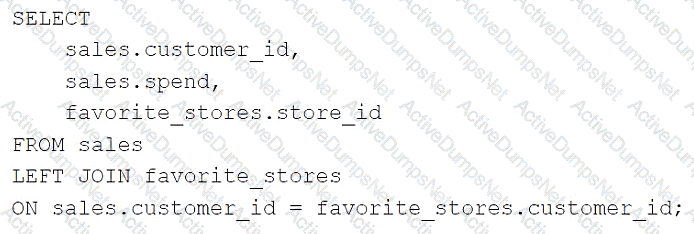
Which of the following will be returned by the above query?
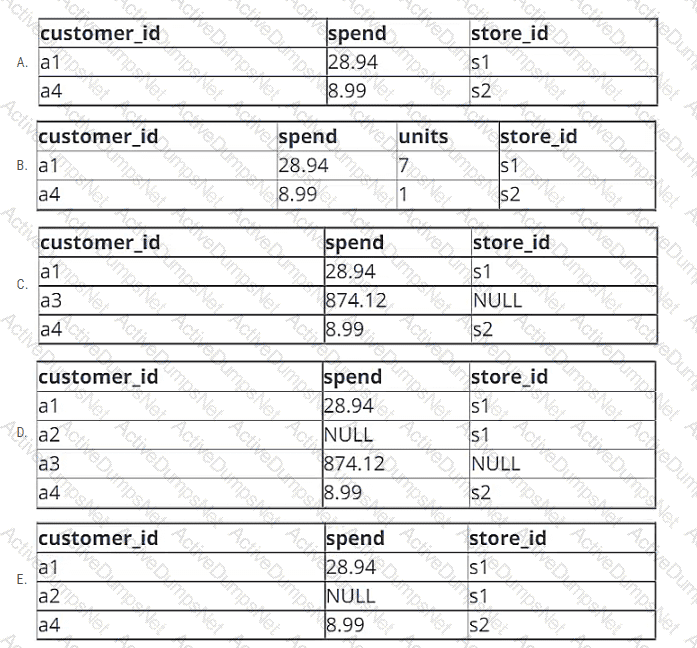
An organization is looking for an optimized storage layer that supports ACID transactions and schema enforcement. Which technology should the organization use?
A data engineer wants to create a new table containing the names of customers who live in France.
They have written the following command:
CREATE TABLE customersInFrance
_____ AS
SELECT id,
firstName,
lastName
FROM customerLocations
WHERE country = ’FRANCE’;
A senior data engineer mentions that it is organization policy to include a table property indicating that the new table includes personally identifiable information (Pll).
Which line of code fills in the above blank to successfully complete the task?
A data engineer has created a new database using the following command:
CREATE DATABASE IF NOT EXISTS customer360;
In which of the following locations will the customer360 database be located?
A Delta Live Table pipeline includes two datasets defined using streaming live table. Three datasets are defined against Delta Lake table sources using live table.
The table is configured to run in Production mode using the Continuous Pipeline Mode.
What is the expected outcome after clicking Start to update the pipeline assuming previously unprocessed data exists and all definitions are valid?
A data engineer needs to optimize the data layout and query performance for an e-commerce transactions Delta table. The table is partitioned by "purchase_date" a date column which helps with time-based queries but does not optimize searches on user statistics "customer_id", a high-cardinality column.
The table is usually queried with filters on "customer_i
d" within specific date ranges, but since this data is spread across multiple files in each partition, it results in full partition scans and increased runtime and costs.
How should the data engineer optimize the Data Layout for efficient reads?
Which of the following commands will return the number of null values in the member_id column?
A Delta Live Table pipeline includes two datasets defined using STREAMING LIVE TABLE. Three datasets are defined against Delta Lake table sources using LIVE TABLE.
The table is configured to run in Development mode using the Continuous Pipeline Mode.
Assuming previously unprocessed data exists and all definitions are valid, what is the expected outcome after clicking Start to update the pipeline?
A data engineer wants to create a data entity from a couple of tables. The data entity must be used by other data engineers in other sessions. It also must be saved to a physical location.
Which of the following data entities should the data engineer create?
A data engineer needs access to a table new_table, but they do not have the correct permissions. They can ask the table owner for permission, but they do not know who the table owner is.
Which of the following approaches can be used to identify the owner of new_table?
A data engineering team has noticed that their Databricks SQL queries are running too slowly when they are submitted to a non-running SQL endpoint. The data engineering team wants this issue to be resolved.
Which of the following approaches can the team use to reduce the time it takes to return results in this scenario?
A data engineer has a Job that has a complex run schedule, and they want to transfer that schedule to other Jobs.
Rather than manually selecting each value in the scheduling form in Databricks, which of the following tools can the data engineer use to represent and submit the schedule programmatically?
A data engineer has been using a Databricks SQL dashboard to monitor the cleanliness of the input data to an ELT job. The ELT job has its Databricks SQL query that returns the number of input records containing unexpected NULL values. The data engineer wants their entire team to be notified via a messaging webhook whenever this value reaches 100.
Which of the following approaches can the data engineer use to notify their entire team via a messaging webhook whenever the number of NULL values reaches 100?
Which of the following code blocks will remove the rows where the value in column age is greater than 25 from the existing Delta table my_table and save the updated table?
Which method should a Data Engineer apply to ensure Workflows are being triggered on schedule?
A data engineer needs to ingest from both streaming and batch sources for a firm that relies on highly accurate data. Occasionally, some of the data picked up by the sensors that provide a streaming input are outside the expected parameters. If this occurs, the data must be dropped, but the stream should not fail.
Which feature of Delta Live Tables meets this requirement?
A data engineer is working on a Databricks project that utilizes cloud storage. The data engineer wants to load several json files from containers on a storage account as soon as the file arrives within the storage account.
Which syntax should the data engineer follow to first load the files into a dataframe and check that it is working as expected using Python?
A new data engineering team team has been assigned to an ELT project. The new data engineering team will need full privileges on the table sales to fully manage the project.
Which command can be used to grant full permissions on the database to the new data engineering team?
Which of the following describes the type of workloads that are always compatible with Auto Loader?
A data engineer runs a statement every day to copy the previous day’s sales into the table transactions. Each day’s sales are in their own file in the location "/transactions/raw".
Today, the data engineer runs the following command to complete this task:

After running the command today, the data engineer notices that the number of records in table transactions has not changed.
Which of the following describes why the statement might not have copied any new records into the table?
A data engineer is using the following code block as part of a batch ingestion pipeline to read from a composable table:
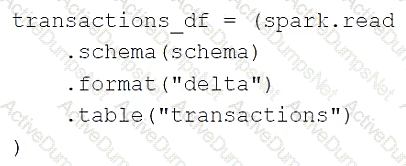
Which of the following changes needs to be made so this code block will work when the transactions table is a stream source?
A data engineer has written a function in a Databricks Notebook to calculate the population of bacteria in a given medium.

Analysts use this function in the notebook and sometimes provide input arguments of the wrong data type, which can cause errors during execution.
Which Databricks feature will help the data engineer quickly identify if an incorrect data type has been provided as input?
Total 153 questions





